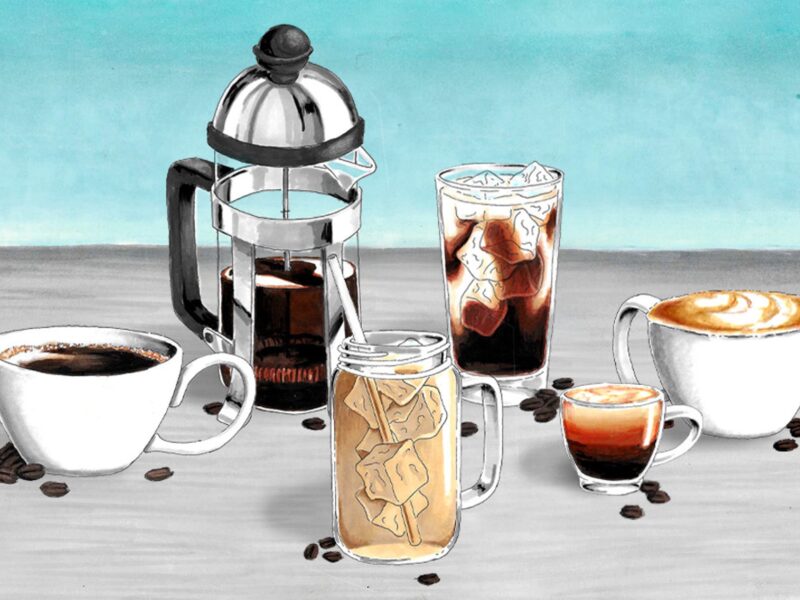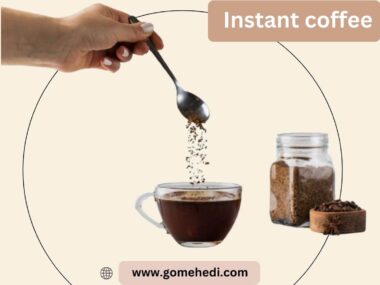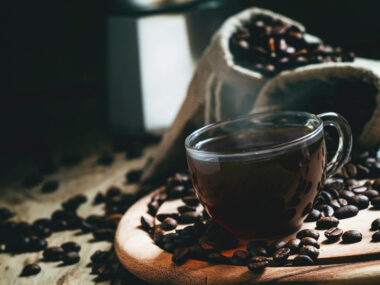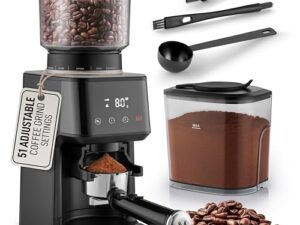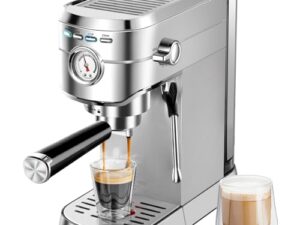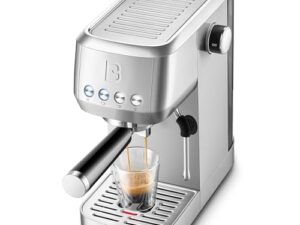Making decaf coffee at home is simple and satisfying. It lets you enjoy coffee’s rich flavors without the caffeine kick.
Decaf coffee is perfect for those who love coffee but want to avoid caffeine. You can make decaf coffee just as tasty as regular coffee. Whether you prefer using a coffee maker, French press, or espresso machine, there are easy methods to brew a delicious cup.
This guide will show you how to make decaf coffee step by step. You’ll learn tips to enhance the flavor and enjoy a perfect cup every time. Get ready to savor a delightful coffee experience without the jitters.
Choosing Coffee Beans
Decaf coffee can be a delightful alternative for those who love coffee but want to avoid caffeine. One crucial step in making great decaf coffee is choosing the right coffee beans. The type of beans you select greatly influences the taste and overall experience. Let’s explore different types of decaf beans and their flavor profiles to help you make an informed decision.
Types Of Decaf Beans
Decaf coffee beans come in various types, each offering unique characteristics. Understanding these can help you choose the best beans for your taste.
- Arabica Beans – Known for their mild and aromatic flavor, Arabica beans are a popular choice for decaf coffee. They have a lower caffeine content naturally, making them easier to decaffeinate.
- Robusta Beans – These beans are stronger and more bitter than Arabica. They contain more caffeine, so the decaffeination process is more intensive. Robusta beans are often used in blends to add body and depth.
- Blends – Many decaf coffees are blends of Arabica and Robusta beans. This combination balances the smoothness of Arabica with the robustness of Robusta, creating a well-rounded flavor.
Here is a quick comparison of the two main types of beans:
| Bean Type | Flavor | Caffeine Content |
|---|---|---|
| Arabica | Mild, Aromatic | Lower |
| Robusta | Strong, Bitter | Higher |
Flavor Profiles
The flavor profile of decaf coffee can vary widely based on the beans and decaffeination process used. Here are some common flavor notes you might encounter:
- Fruity – Some decaf coffees have bright, fruity notes. These can include flavors like berries, citrus, or even tropical fruits. Arabica beans often provide these flavors.
- Nutty – Nutty flavors are warm and comforting. Think of hazelnuts, almonds, or even peanuts. This profile is common in both Arabica and Robusta blends.
- Chocolatey – A rich, chocolatey taste is a favorite among coffee lovers. This can range from milk chocolate to dark, intense cocoa. Blends with Robusta beans often highlight these flavors.
- Spicy – Spicy flavors add an exotic twist to decaf coffee. Notes of cinnamon, clove, or even black pepper can be found. These flavors are usually more pronounced in darker roasts.
Understanding these flavor profiles can help you choose the right decaf coffee for your palate. Whether you prefer fruity and bright or rich and chocolatey, there’s a decaf coffee out there for you.
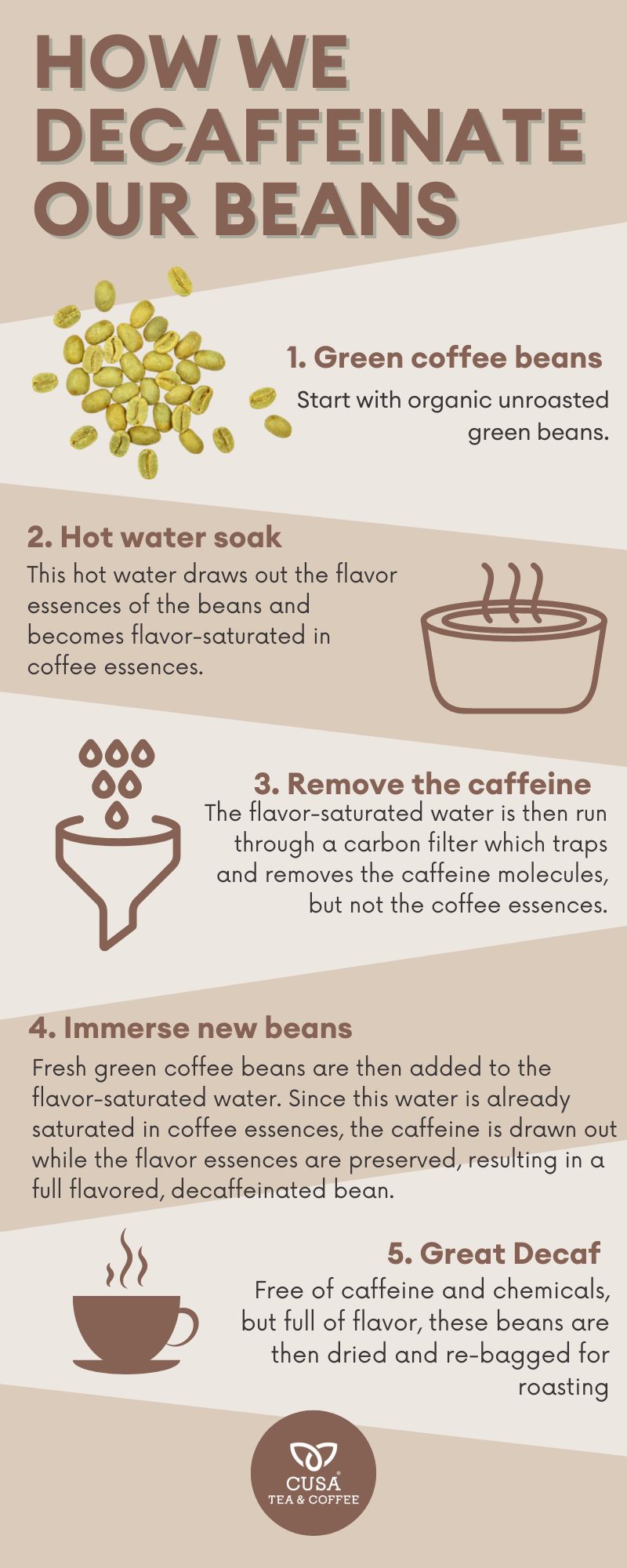
Credit: www.drinkcusa.com
Decaffeination Methods
Making decaf coffee involves removing most of the caffeine from coffee beans. There are several decaffeination methods, each with its own benefits and drawbacks. Understanding these methods helps in choosing the best decaf coffee for your taste and health needs.
Chemical Process
The chemical process is one of the most common decaffeination methods. It uses solvents to extract caffeine from coffee beans. The most popular solvents are methylene chloride and ethyl acetate.
Here’s how it works:
- Coffee beans are steamed to open their pores.
- Beans are rinsed with the solvent to dissolve the caffeine.
- The beans are steamed again to remove any solvent residue.
This method is efficient and preserves much of the coffee’s original flavor. Methylene chloride is safe in the small amounts used. Ethyl acetate is found naturally in fruits, so it is often labeled as “natural.”
Pros:
- Preserves flavor well.
- Efficient caffeine removal.
- Cost-effective.
Cons:
- Some people prefer to avoid chemicals.
- Requires careful handling.
Water Process
The water process, also known as the Swiss Water Process, uses water and filters to remove caffeine. This method is chemical-free and is preferred by those looking for a natural decaf option.
Here’s a step-by-step outline:
- Coffee beans are soaked in hot water to dissolve caffeine and flavor compounds.
- The water is passed through a charcoal filter that traps the caffeine but allows the flavors to pass through.
- The caffeine-free beans are then re-soaked in the flavor-rich water to reabsorb the flavor compounds.
This process is repeated until the desired caffeine level is achieved. The water process is known for preserving the coffee’s natural taste and being environmentally friendly.
Pros:
- No chemicals used.
- Retains natural flavors well.
- Environmentally friendly.
Cons:
- Can be more expensive.
- May not remove all caffeine as effectively as chemical methods.
Decaffeinated Coffee
Decaffeinated coffee offers a great alternative for those who enjoy coffee without the caffeine jolt. It’s important to choose a decaf coffee that suits your preference in taste and health considerations.
Factors to consider:
- Flavor: Different methods affect the flavor profile. The chemical process often keeps flavors intact, while the water process offers a purer taste.
- Health: Some prefer chemical-free options like the Swiss Water Process for health reasons.
- Cost: Decaf coffee can be more expensive due to the additional processing.
Here’s a comparison table:
| Method | Pros | Cons |
|---|---|---|
| Chemical Process | Efficient, preserves flavor, cost-effective | Uses chemicals, requires careful handling |
| Water Process | No chemicals, retains natural flavors, eco-friendly | Can be more expensive, less effective caffeine removal |
Decaf coffee is a great way to enjoy the rich taste of coffee without the buzz. Choose the decaffeination method that best aligns with your preferences and lifestyle.
Grinding The Beans
Decaf coffee can be a delicious alternative to regular coffee. To make it taste great, you need to grind the beans correctly. The grind size affects the flavor and strength of your coffee. Let’s look into why grind size is important and what grind levels are recommended for different brewing methods.
Grind Size Importance
The grind size of your coffee beans plays a crucial role in the taste and quality of your decaf coffee. Different brewing methods require different grind sizes to ensure the best extraction of flavors. Here are some key reasons why grind size matters:
- Extraction Rate: Finer grinds expose more surface area of the coffee bean to water, leading to faster extraction. Coarser grinds extract more slowly.
- Flavor Profile: The right grind size helps balance the flavors in your coffee, avoiding over-extraction (bitter taste) or under-extraction (sour taste).
- Brewing Time: Different grind sizes suit different brewing times. A finer grind is ideal for quick methods like espresso, while a coarser grind works well for slow methods like French press.
Choosing the correct grind size ensures that your coffee tastes just right, whether it’s rich and bold or smooth and mild.
Recommended Grind Levels
Various brewing methods require specific grind levels to achieve the best flavor. Here are some common brewing methods and the recommended grind levels for each:
| Brewing Method | Grind Level | Description |
|---|---|---|
| Espresso | Fine | Almost powdery; similar to table salt |
| Pour Over | Medium-Fine | Similar to sand; slightly finer than table salt |
| Drip Coffee Maker | Medium | Resembles granulated sugar |
| French Press | Coarse | Similar to sea salt; larger, more distinct particles |
| Cold Brew | Extra Coarse | Chunky, like coarse ground pepper |
Using the right grind level for your brewing method ensures optimal flavor extraction and a satisfying cup of decaf coffee. Experiment with different grind sizes to find the perfect balance for your taste preferences.
Brewing Techniques
Decaf coffee is a fantastic choice for those who want to enjoy the rich flavors of coffee without the caffeine. Brewing techniques play a vital role in achieving the perfect cup of decaf coffee. The method you choose can significantly impact the coffee flavor profile, coffee extraction time, and overall enjoyment. Let’s dive into two popular brewing methods: French Press and Pour Over.
French Press
Using a French Press is a classic and simple way to brew decaf coffee. This method allows for full immersion, which can enhance the coffee flavor profile. Follow these steps to make the best decaf coffee with a French Press:
- Start with the best decaf beans you can find. Quality beans make a big difference.
- Grind the beans to a coarse consistency. The correct coffee grind size is crucial for a French Press.
- Heat water to around 200°F (93°C). Proper water temperature ensures optimal extraction.
- Add the ground coffee to the French Press. Use a coffee-to-water ratio of about 1:15. For example, use 30 grams of coffee for 450 ml of water.
- Pour the hot water over the grounds, saturating them evenly. Let the coffee steep for about 4 minutes. Adjust the coffee extraction time if needed.
- Gently press the plunger down. Pour the coffee into your cup and enjoy.
Remember, the French Press method is forgiving and allows you to experiment with different variables like grind size and steeping time to achieve your perfect cup.
Pour Over
The Pour Over method is another excellent choice for brewing decaf coffee. This method provides more control over the brewing process, which can result in a cleaner taste. Here’s how you can do it:
- Choose high-quality decaffeinated coffee beans. The caffeine removal process should not compromise the flavor.
- Grind the beans to a medium-fine consistency. The right coffee grind size is essential for Pour Over.
- Boil water and let it cool to about 200°F (93°C). The water temperature affects the extraction.
- Place a filter in your dripper and rinse it with hot water. This removes any paper taste and preheats the dripper.
- Add the ground coffee to the filter. Use a coffee-to-water ratio of about 1:16. For instance, use 25 grams of coffee for 400 ml of water.
- Pour a small amount of water over the grounds to bloom the coffee. Wait for about 30 seconds.
- Slowly pour the remaining water in a circular motion. This ensures even saturation and extraction.
- Allow the coffee to drip through completely. The total coffee extraction time should be around 3-4 minutes.
The Pour Over method requires a bit more precision and patience, but the reward is a bright and flavorful cup of decaf coffee. Experiment with the variables to find your preferred taste.
Water Quality
Introduction paragraph about How to Make Decaf Coffee and Water Quality…
Filtered Vs. Tap Water
Water quality plays a big role in making decaf coffee. Using the right water can improve the flavor profile of your coffee. There are two main options: filtered water and tap water. Let’s look at each.
Filtered Water:
- Removes impurities and chlorine.
- Enhances the natural flavors of coffee grounds.
- Consistent water quality.
Filtered water offers a clean taste. It ensures that no unwanted flavors affect your decaf coffee. A water filter can remove chemicals and minerals that alter the coffee flavor. This helps in getting a smooth and balanced cup. It is especially useful for those who are sensitive to the taste of chlorine or other tap water additives.
Tap Water:
- Easy to access and convenient.
- Contains minerals that can enhance coffee extraction.
- May have chlorine or other impurities.
Tap water is a common choice for many. It is readily available and contains minerals that help in coffee extraction. These minerals can improve the coffee brewing time and the overall flavor profile. But be aware of the chlorine and other impurities that might affect the taste. If your tap water has a strong taste, consider using filtered water.
Comparison Table:
| Aspect | Filtered Water | Tap Water |
|---|---|---|
| Impurities | Removed | Present |
| Flavor Profile | Clean and Smooth | Varies |
| Convenience | Needs a filter | Easy to access |
Temperature Tips
Temperature is key in coffee preparation. The right temperature ensures proper coffee extraction and enhances the flavor profile. Here are some tips to get the ideal brewing temperature for your decaffeinated coffee.
Ideal Brewing Temperature:
- The ideal range is between 195°F to 205°F (90°C to 96°C).
- Avoid boiling water as it can burn the coffee grounds.
- Too low temperature can result in weak coffee.
Boiling water can make your coffee taste bitter. It can also burn the delicate decaf coffee grounds. On the other hand, water that is too cool will not extract the flavors properly. Aim for the sweet spot between 195°F and 205°F. This range allows for balanced coffee extraction and a rich flavor profile.
Brewing Methods:
- Drip Coffee Maker: Most machines heat water to the right temperature.
- French Press: Boil water, then let it cool for 30 seconds before pouring.
- Pour Over: Use a thermometer to check water temperature.
Different brewing methods require attention to water temperature. For a drip coffee maker, the machine usually regulates the temperature. For a French press, boil the water and let it cool for 30 seconds before pouring over the coffee grounds. For a pour-over method, use a thermometer to ensure the water is in the ideal range.
Remember, the right temperature helps in getting the best flavor from your caffeine-free coffee. It ensures that your decaf coffee is not too bitter or too weak. By following these temperature tips, you can enjoy a perfect cup of decaf coffee every time.

Credit: www.homegrounds.co
Adding Flavor
Making decaf coffee can be just as enjoyable as regular coffee. Adding flavor to your decaf coffee can enhance your coffee-drinking experience. With a few simple ingredients, you can turn a plain cup of decaf into a delightful treat.
Spices And Syrups
Spices and syrups are a great way to add flavor to your decaf coffee. They are easy to use and can transform your coffee into a gourmet experience.
Spices can add a warm, aromatic touch to your coffee. Here are some popular options:
- Cinnamon: Adds a sweet, spicy flavor.
- Nutmeg: Provides a warm, nutty taste.
- Cardamom: Offers a unique, exotic aroma.
- Cloves: Adds a strong, earthy flavor.
To use spices, sprinkle a small amount into your coffee grounds before brewing. You can also stir them directly into your brewed coffee.
Syrups are another fantastic option for flavoring your decaf coffee. They come in a variety of flavors and are easy to mix. Some popular syrup flavors include:
- Vanilla: Adds a sweet, creamy taste.
- Caramel: Provides a rich, buttery flavor.
- Hazelnut: Offers a nutty, smooth taste.
- Chocolate: Adds a deep, sweet flavor.
To use syrups, add one or two tablespoons to your coffee. Adjust the amount to suit your taste. Mix well to ensure the syrup is fully incorporated.
Milk Alternatives
Milk alternatives can also enhance the flavor of your decaf coffee. They are perfect for those who are lactose intolerant or prefer a dairy-free option.
Here are some popular milk alternatives:
| Milk Alternative | Flavor Profile |
|---|---|
| Almond Milk | Light, nutty flavor |
| Soy Milk | Rich, creamy taste |
| Oat Milk | Sweet, slightly malty flavor |
| Coconut Milk | Tropical, sweet flavor |
To use milk alternatives, simply replace your regular milk with your chosen alternative. You can heat the milk for a warm drink or use it cold for an iced coffee.
Milk alternatives can be frothed just like regular milk. Frothing adds a creamy texture to your coffee. Use a milk frother or shake the milk in a jar to create foam.
Experiment with different milk alternatives to find your favorite. Each type offers a unique flavor and texture to your decaf coffee.
Storing Decaf Coffee
Decaf coffee offers the same rich flavors of regular coffee without the caffeine. Making decaf coffee involves selecting the right beans, brewing, and storage. Storing decaf coffee properly is crucial for maintaining its freshness and taste.
Best Storage Practices
To keep your decaf coffee tasting fresh, follow these storage practices:
- Airtight Containers: Use containers that seal out air. Exposure to air can cause coffee to lose its flavor.
- Cool, Dark Place: Store your coffee in a cool, dark place like a pantry. Avoid places that get direct sunlight or heat.
- Avoid Fridge and Freezer: The moisture in the fridge and freezer can damage the coffee beans. It’s better to keep them at room temperature.
- Buy in Small Quantities: Purchase only what you can use within a few weeks. This helps ensure your coffee stays fresh.
Follow these practices to enjoy the best possible taste from your decaf coffee.
Shelf Life
Understanding the shelf life of decaf coffee helps in planning your purchases and ensuring you drink fresh coffee.
Whole Beans: Whole decaf coffee beans have a longer shelf life compared to ground coffee. When stored properly, they can stay fresh for up to three months.
Ground Coffee: Ground decaf coffee has a shorter shelf life. It’s best to use it within one month of opening.
The table below provides a quick reference:
| Type | Shelf Life |
|---|---|
| Whole Beans | Up to 3 months |
| Ground Coffee | Up to 1 month |
Best Decaf Beans
Choosing the right decaf beans is important for great-tasting coffee. Here are some top options:
- Swiss Water Decaf: This method uses water to remove caffeine, keeping the flavor intact. Many brands offer Swiss Water Decaf, known for its rich taste.
- Organic Decaf: Look for beans that are organic. They are grown without synthetic chemicals, ensuring a clean and natural flavor.
- Single-Origin Decaf: Single-origin beans come from one place, providing unique and distinct flavors. Many coffee lovers prefer single-origin for its pure taste.
These options can provide a delightful decaf coffee experience. Choose beans that fit your taste preferences and enjoy a delicious cup of decaf coffee.
Health Benefits
Decaf coffee has gained popularity for its delicious taste and reduced caffeine content. People choose decaf for various reasons, but one key factor is its health benefits. Let’s dive into some of the benefits you can enjoy with decaf coffee.
Lower Caffeine Intake
One of the main reasons people switch to decaf coffee is to lower their caffeine intake. High caffeine consumption can lead to issues such as:
- Insomnia
- Increased heart rate
- Anxiety
- Digestive problems
Reducing caffeine can help improve sleep quality. Better sleep means better health. Decaf coffee still provides the comfort of a warm drink without the jitters. This makes it a great choice for those sensitive to caffeine.
For those with heart conditions, reducing caffeine can help lower blood pressure. This is crucial for maintaining heart health. Pregnant women are often advised to limit caffeine. Decaf coffee allows them to enjoy coffee safely.
Let’s look at a quick comparison:
| Regular Coffee | Decaf Coffee |
|---|---|
| 95 mg of caffeine per 8 oz | 2 mg of caffeine per 8 oz |
As shown, decaf coffee has significantly less caffeine. This makes it a healthier option for many people.
Antioxidant Properties
Decaf coffee is rich in antioxidants. Antioxidants help fight free radicals in the body. Free radicals can cause cell damage, leading to various diseases. By drinking decaf coffee, you can boost your antioxidant intake.
Antioxidants in decaf coffee help reduce inflammation. Lower inflammation can decrease the risk of chronic diseases like heart disease and arthritis. Here are some key antioxidants found in decaf coffee:
- Chlorogenic acid
- Melanoidins
- Quinides
Chlorogenic acid helps regulate blood sugar levels. This can be beneficial for people with diabetes. Melanoidins have anti-inflammatory properties. They support gut health and immune function. Quinides improve insulin sensitivity. This helps reduce the risk of type 2 diabetes.
In summary, decaf coffee offers many health benefits. It provides lower caffeine intake and a rich source of antioxidants. Enjoy your cup of decaf coffee knowing it’s good for your health!

Credit: www.compoundchem.com
Frequently Asked Questions
What Is Decaf Coffee?
Decaf coffee is coffee with most of its caffeine removed. It’s a great choice for those who want to limit caffeine intake.
How Is Decaf Coffee Made?
Decaf coffee is made by removing caffeine from coffee beans. This can be done using water, solvents, or carbon dioxide.
Does Decaf Coffee Taste Different?
Decaf coffee can taste slightly different due to the decaffeination process. However, high-quality decaf retains most of its flavor.
Is Decaf Coffee Completely Caffeine-free?
No, decaf coffee still contains a small amount of caffeine. However, it’s significantly less than regular coffee.
Conclusion
Making decaf coffee at home is easy and rewarding. Choose quality decaf beans. Grind them fresh for the best flavor. Use your favorite brewing method. Adjust water temperature and brewing time. Enjoy the rich, smooth taste without the caffeine. Experiment with different beans and techniques.
Find what you love the most. Relax and savor every cup. Share your homemade decaf coffee with friends. Experience the joy of a perfect brew. Happy brewing!
